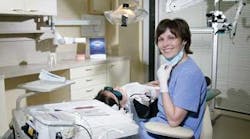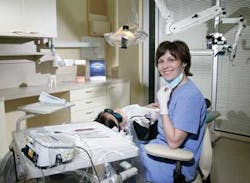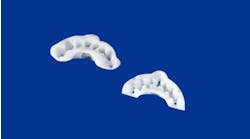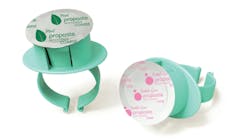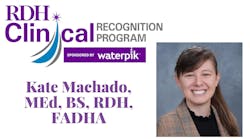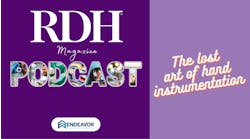by Lynne H. Slim, RDH, BSDH, MSDH
One of the highlights of the RDH Under One Roof 2007 conference in Washington, D.C., was getting to spend time with friends, and one in particular comes to mind. Catherine Fairfield, RDH, and I co-presented on periodontal biofilms at UOR, and we were able to spend some quality time together after our presentation was over. Catherine is a Canadian who lives in Calgary, where she practices dental hygiene full time and teaches part time as a clinical educator in graduate periodontal studies at the University of British Columbia. Catherine and I are periodontal nerds, and we are happiest when we are discussing periodontal pathogens, advanced instrumentation, or disinfecting periodontal pockets. On the spur of the moment, we decided to tour Georgetown and quickly settled in at a nice restaurant where we pored over the latest issue of a peer-reviewed periodontal journal. How many hygienists do you know who are “nerdie” enough to be happiest nibbling on a salad while discussing the latest research literature surrounding the role of A. actinomycetemcomitans in periodontal infections?
Catherine and I like to discuss any and all issues related to nonsurgical, anti-infective periodontal therapy and quite recently, we’ve been mulling over a new in-office technology called Periowave™ photodisinfection. Catherine has adopted this pocket disinfection technology into her Calgary practice since March 2006 and lectures for the Canadian company Ondine Biopharma Corporation that manufactures the product. Periowave™ is approved for use in Canada, the European Union, and United Kingdom, and is currently pending FDA approval for use in the United States.
Antimicrobial photodynamic therapy has been used in medicine by combining a nontoxic photoactive dye or photosensitizer with harmless visible light to kill microorganisms, yeasts, and even viruses. A professor at the Eastman Dental Institute, University College London, England, named Michael Wilson first proposed the use of photosensitization for the nonsurgical treatment of periodontal diseases in 1989. The photosensitizer in the Periowave™ treatment kit used to zap periodontal pathogens is methylene blue, and it is applied directly into the pocket with a blunt irrigation needle to the apex of the pocket. Next, a diode laser (Periowave™) attached to a fiber-optic cable, handpiece, and light-diffusing tip that is shaped like a periodontal probe illuminates the pocket and activates the photosensitizing agent.
In introducing this new disinfection product to RDH readers, I thought it best to ask Catherine some questions about her experiences with it, and like me, she was happy to put her fingers to the keyboard and type away!
When did you first get introduced to Periowave™ and are you using it routinely in clinical practice?
Periowave™ contacted me in the summer of 2005 upon the recommendation of educators and colleagues in the dental hygiene profession and dental field. I continue to be an educator, presenter, and consultant to Ondine Biopharma Corporation at this time.
Clinical trial results to date1 that have compared SRP alone to SRP with photodisenfection have been overwhelmingly positive. Our office has had very positive clinical results, but as with all adjunctive therapies, my results do not always provide the “answer” that I would like. We must remember as clinicians that this product was designed as an adjunctive therapy to thorough mechanical debridement. In other words, there are further clinical parameters and individual patient conditions that do not allow this procedure to be the panacea that we all dream of. Periowave™ is a wonderful noninvasive, nonantibiotic first treatment option as an LDA to accompany thorough nonsurgical treatment.
My most memorable Periowave™ case will always be my first case. This young woman, 13 years old, presented with an isolated vertical defect with 7 mm probing depth (PD) and bleeding on probing (BOP) on the mesial of her first lower left molar. Initial therapy, consisting of full-mouth debridement with local anesthesia for the lower left quadrant, resulted in PD and BOP remaining unchanged. A three-month periodontal maintenance schedule was introduced with one course of systemic amoxicillin (250 mg) and metronidazole (250 mg) three times daily (TID) for seven days as recommended by the periodontist. Clinical findings were unchanged at the subsequent three-month PM, at which time SRP was performed followed by the same systemic antibiotic regimen as before.
In March of 2006, a single photodisinfection treatment with Periowave™ was utilized in the site after subgingival debridement. In May 2007, the clinical reevaluation found the PD in the treatment site reduced to 4 mm with no BOP. To date, the PD and BOP in this site remain stable with routine periodontal maintenance. This site is monitored closely for any changes at which time a second Periowave™ treatment will be recommended along with any surgical treatment options if necessary.
Based on evidence, do you believe that debriding and disinfecting pockets is better than debriding alone?
There is definitely evidence supporting combining debridement and disinfection subgingivally to provide more comprehensive treatment for patients showing signs of inflammation or infection. Drisko recommends that mechanical and chemotherapeutic approaches be utilized to minimize or eliminate microbial biofilm both supra and subgingivally. This anti-infective therapy is certainly warranted in cases that have not shown clinical improvements such as reduced PD and most importantly, reduced BOP with mechanical debridement alone. There is also evidence indicating that bacteria such as Pg and Aa are not entirely removed with conventional mechanical instrumentation alone, and further evidence shows that these putative pathogens are capable of invading host cells, which may lead to recurrent periodontal diseases or refractory periodontal diseases.
Have you ever used other local delivery antimicrobial agents (LDAs) like Arestin®, Atridox®, or PerioChip®?
Atridox® is the only other LDA, other than chlorhexidine gluconate or CHX, available in Canada. I have had limited use with Atridox® in the past, and it was utilized only locally in unresponsive sites, after initial therapy or after the re-evaluation or at later times in recurrent periodontal disease sites. The difficulties with Atridox were primarily in the delivery system, as it was sticky and difficult to deliver to the base of the pocket. Our results were mixed, as with many LDAs, with some sites responding favorably and others not so, which may be due to many factors such as delivery, access, and the shape and size of the periodontal defect. I have never been concerned about additional costs for any treatment, as our treatment is recommended based on clinical/radiographic findings, science, and practicality for each individual patient with his/her best interest at the center of all treatment decisions.
How does Periowave™ differ from other LDAs?
The delivery of Periowave™ is different from other local delivery agents (LDAs) as it is a simple two-step procedure in which the photodisinfection solution is irrigated into the specific site with a blunt-ended cannula, and then immediately illuminated for 60 seconds with a nonthermal diode laser light. This specific light wavelength is designed to activate the proprietary Periowave™ solution, eliminating the putative pathogens and virulence factors within the 60-second time frame. The ability of the solution and light to access difficult-to-reach areas, such as concavities, furcations, and the deepest portions of the pocket are seen as advantages over other LDAs.
Are there any safety issues to be concerned about when using Periowave™?
This photodisinfection technique is safe. There are relatively few contraindications for Periowave™ treatment. The proprietary solution utilized methylene blue at 0.01 percent concentration, which is completely safe and has been used in humans for more than 100 years with no side effects. The nonthermal diode laser utilizes a 670 nm wavelength and provides negligable amounts of heat, will cause no damage to the dentition, dental implants, or the surrounding hard and soft tissues. There is no patient discomfort and no concern about the patient ingesting residual solution.
About the Author
Lynne H. Slim, RDH, BSDH, MSDH, is a practicing hygienist/periodontal therapist who has more than 20 years’ experience in both clinical and educational settings. She is also president of Perio C Dent Inc. (Perio-Centered Dentistry), a practice-management consulting firm that specializes in creating outstanding dental hygiene teams. Lynne is a member of the Speaking and Consulting Network (SCN) that was founded by Linda Miles, and has won two first-place journalism awards from ADHA. Lynne is also owner/moderator of a periodontal therapist yahoo group: http://yahoogroups.com/group/periotherapist. She can be contacted at [email protected].
References
1 Anderson R, Loebe, N, Hammond D, Wilson M. Treatment of periodontal disease by photodisinfection compared to scaling and root planing. JClinDent 2007; 18(2):34-38.
